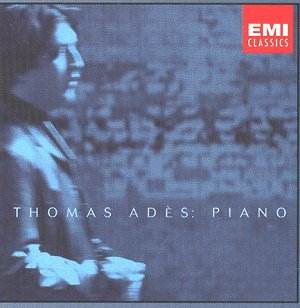THOMAS ADÈS: PIANO
Niccolò CASTIGLIONI (b.1932) Come io passo l'estate.
Edvard GRIEG (1843-1907) Slåtter, Op. 72 - No. 14, the Goblins'
Bridal Procession at Vossevangen; No. 15, The Skudal Bride; No. 10, Knut
Lurasens halling.
Alexey STANCHINSKY (b. 1926) Canon a
4 voci. Piano Sonata No. 2 in G.
György KURTAG (b. 1926) Jatékok - Les Adieux in
Janácek's Manner; The mad girl with the flaxen hair; Keringö;
Hommage à Nancy Sinatra; Hommage à Csajkovszkij.
Leos JANACEK (1854-1928) Intimate Sketches - No. 8, I await you!;
Tears; Im memory of a just person; Preludium; Korál.
Ferruccio BUSONI (1866-1924) Sonatina ad usum infantis (Sonatine
No. 3)
Igor STRAVINSKY (1882-1971) Souvenir d'une marche boche. Valse
pour les enfants. Piano-Rag-Music.
Conlon NANCARROW (1912-97) Three Canons for
Ursula.
 Thomas Adès
(piano).
Thomas Adès
(piano).
 EMI CDC5 57051-2 [72'01]
[DDD]
EMI CDC5 57051-2 [72'01]
[DDD]
Crotchet

Perhaps because of his success as a precociously talented young composer,
Thomas Adès the pianist has received less coverage. However, performances
of his own Concerto conciso (written very much for himself as soloist)
have left no doubt as to his prowess.
It is fitting that for this solo album Adès has put forward an alternative
survey of twentieth century piano music. I nearly burst into applause when
I saw that Grieg's Slåtter, Op. 72 is represented by
three excerpts. These pieces have remained stubbornly under-recorded in the
catalogue, presumably because they are several light years away from the
cosier world of the Lyric Pieces. Adès can therefore be
unapologetically earthy in both The Skudal Bride and in the bagpipe-like
drones of Knut Luråsen's halling (the latter a well-chosen end
to the selection).
Castiglioni's Come io passo l'estate belongs firmly with the genre
of children's pieces whose domain lies with adults. The ten movements are
a travel diary from the Italian Alps and manage to encompass both schmaltz
and pointillism.
Alexey Stanchinsky is represented by two pieces. The Canon a 4 voci
is pianissimo, concentrated and inward-looking: an ideal contrast
to the Grieg that preceded it. The Second Piano Sonata uses the tonality
of G at arrival points. Its first movement, 'Fuga', is particularly impressive,
emerging as an organ-like processional.
Excerpts from Janacek's Jatékók ('Games') build on familiar
models, most clearly The mad girl with the flaxen hair (obsessive
repetitions of Debussian motives) and Hommage à Csajkovszkij,
in which the opening of the First Piano Concerto is transmogrified into insane
clusters and mad glissandi. At the other end of the scale, the excerpts
from Janácek's Intimate Sketches show the more internalised
side of Adès. I await you is left tantalisingly hanging in
mid-phrase and the final Chorale is distorted through a twentieth century
mirror.
The Busoni shows Adès able to project the composer's intended atmospheres
perfectly: The Andante melancolico is just that. Adès lets
his hair down in the Stravinsky pieces, but opts to close the disc with
Nancarrow's Three Canons for Ursula. If you can forget the maths of
it all, these pieces can take on an otherworldly aspect that is well projected
in this performance.
A thought-provoking selection, intelligently chosen, finely recorded (in
Potton Hall) and played with the utmost advocacy.
Reviewer
Colin Clarke
Performance

Recording

